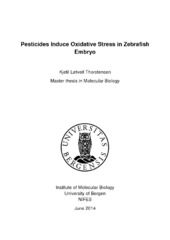Pesticides Induce Oxidative Stress in Zebrafish Embryo
Master thesis
Permanent lenke
https://hdl.handle.net/1956/11678Utgivelsesdato
2014-06-02Metadata
Vis full innførselSamlinger
Sammendrag
Aquaculture is an industry in rapid global growth. The increased demand and therefore production of aquacultural goods is bound to drain natural marine resources if fish are to continue being fed feeds based solely on marine products. To compensate for the lack of traditional marine based feed, a mixture of agricultural and marine based feed can be used, replacing some of the fish oil with vegetable oil. However, the vegetable feed may include traces of pollutants such as pesticides commonly used in agriculture. Several pesticides are more toxic to marine animals than to terrestrial animals, and bioaccumulate to a higher degree in marine animals. Thus, introduction of pesticides through fish feed can have negative effects for both the fish and consumers of aquaculture products. Some of the most used pesticides, such as endosulfan (ESF) and chlorpyrifos (CPF) are neurotoxins designed to kill insects by interacting with their nervous system. Several pesticides also have a secondary toxic ability to induce reactive oxygen species (ROS), which can lead to oxidative stress in the fish. To gain more knowledge about the ROS inducing effects of ESF and CPF, toxicology tests were done using embryos of zebrafish (Danio rerio) as a model system. From a 6 hours post fertilization (hpf) to 72 hpf dose response test, the lethal dosage was found to be 500,000 μg/L ESF and 20,000 μg/L CPF. A 14 days post fertilization survival test using the exposure time from 6 hpf - 72 hpf, indicated 50,000 μg/L ESF being a lethal concentration. ESF caused negative effects, such as malformations, late hatching and reduced activity in concentrations above 20,000 μg/L and all of these were dead by day 14. CPF exposure did not seem to affect development at concentrations up to 10,000 μg/L. H2DCFDA can be used to determine ROS generation in living cells. H2DCFDA freely diffuse into exposed cells and will produce an increasing green fluorescence signal with increasing levels of ROS in the cells. ESF caused an increasing fluorescence gradient from 10,000 μg/L to 50,000 μg/L. This increase was also seen in CPF, but the signal was much weaker and harder to differentiate. qPCR on isolated RNA from exposed embryos indicated that ESF had mostly a downregulatory effect on genes related to antioxidants and the gene cyp1a1, but might stimulate vtg1 expression at high levels. CPF had mostly stable expression, except for gclc, which had a significant upregulation. ESF induces more ROS than CPF at high concentrations, but CPF is more acutely lethal then ESF.
